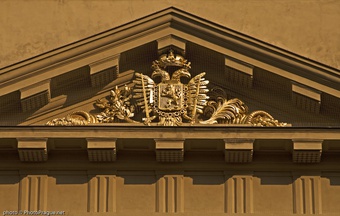
Classicism
Passion was replaced by the rationality of the enlightenment, illusion by pragmatism, and monumental splendor by intentional simplicity. In the European context, the principle of Classicism (or alternatively Neo-Classicism, as such style is usually called in Western Europe) is an almost frenzied effort to come closer to Ancient and especially Classical Greece ideals which were understood as representing the ideal society through its art and culture. However, efforts to implement the purely rational approach was, from the beginning, influenced by the romantic view artists and architects had, and this led to simple Neo-classic exteriors concealing richly decorated interiors which could almost remind us of the exquisiteness of antique Rome structures (in Bohemia particularly the Kačina Manor).
In Prague, Classicism is particularly connected to the architecture of residential houses. some were built in the centre of town (Platýz, Smetana Waterfront), as well as for instance in the newly built suburbia of Karlín whose regular chessboard layout is directly influenced by the examples of Ancient cities. Even aristocratic palaces are now subordinated to the Town layout, hence becoming an integral part of the town streets,
giving this sense of "lofty homogeneity" but still presenting impressive fronts ( palace complex in Hybernská Street, Desfours Palace in New Town). Classicism was an important architectural movement that left a significant legacy in Prague and in the whole of Europe. However, for instance the Nostic's (Estates) Theatre built in 1783 in the Old Town and designed by Anton Haffenecker shows very well, when looking at the portico, how much the dying-out Baroque style could still influence. The New Town "Celnice" front (Customs House), today the Building u Hybernů, built by George Fischer between 1808 and 1811 in front of early-Baroque church of the Immaculate Conception of the Virgin Mary, is an interesting ( and an echo of more recent present-day Berlin Mint built by Heinrich Gentz) example of the direct impact of the most contemporary European tendencies on Prague architecture. Another example is the Governor’s Summer Palace above Prague's Stromovka, the facade of which was reconstructed by Georg Fischer between 1804 and 1805. Idealised Gothic forms are laid on simple Classic facades displaying the first examples of historicism in Prague, which took over local architecture after the middle of the 19th century.






